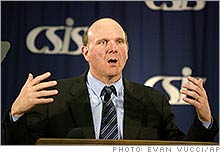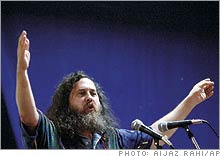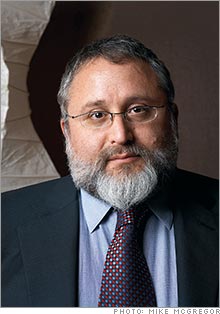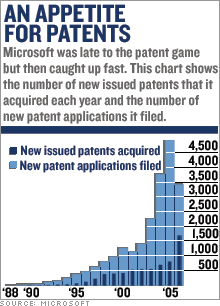
The patent owner: Microsoft CEO Steve Ballmer.
Microsoft takes on the free world
Microsoft claims that free software like Linux, which runs a big chunk of corporate America, violates 235 of its patents. It wants royalties from distributors and users. Users like you, maybe. Fortune's Roger Parloff reports.
By Roger Parloff, senior editor
Fortune
May 14 2007
(Fortune Magazine) -- Free software is great, and corporate America loves it. It's often high-quality stuff that can be downloaded free off the Internet and then copied at will. It's versatile - it can be customized to perform almost any large-scale computing task - and it's blessedly crash-resistant.
A broad community of developers, from individuals to large companies like IBM, is constantly working to improve it and introduce new features. No wonder the business world has embraced it so enthusiastically: More than half the companies in the Fortune 500 are thought to be using the free operating system Linux in their data centers.
But now there's a shadow hanging over Linux and other free software, and it's being cast by Microsoft. The Redmond behemoth asserts that one reason free software is of such high quality is that it violates more than 200 of Microsoft's patents. And as a mature company facing unfavorable market trends and fearsome competitors like Google, Microsoft is pulling no punches: It wants royalties. If the company gets its way, free software won't be free anymore.
The conflict pits Microsoft and its dogged CEO, Steve Ballmer, against the "free world" - people who believe software is pure knowledge. The leader of that faction is Richard Matthew Stallman, a computer visionary with the look and the intransigence of an Old Testament prophet.

The patent owner: Microsoft CEO Steve Ballmer.

The patent hater: Free Software Foundation president Richard
Stallman.

"It's a tinderbox. Patent law's going to be the terrain on
which a big piece of the war's going to be fought. Waterloo is here some where."
--Eben Moglen, Executive director, Software Freedom Law Center

Supreme Court eases patent standards
Caught in the middle are big corporate Linux users like Wal-Mart, AIG, and Goldman Sachs. Free-worlders say that if Microsoft prevails, the whole quirky ecosystem that produced Linux and other free and open-source software (FOSS) will be undermined.
Microsoft counters that it is a matter of principle. "We live in a world where we honor, and support the honoring of, intellectual property," says Ballmer in an interview. FOSS patrons are going to have to "play by the same rules as the rest of the business," he insists. "What's fair is fair."
Microsoft General Counsel Brad Smith and licensing chief Horacio Gutierrez sat down with Fortune recently to map out their strategy for getting FOSS users to pay royalties. Revealing the precise figure for the first time, they state that FOSS infringes on no fewer than 235 Microsoft patents.
It's a breathtaking number. (By comparison, for instance, Verizon's patent suit against Vonage, which now threatens to bankrupt the latter, was based on just seven patents, of which only three were found to be infringing.) "This is not a case of some accidental, unknowing infringement," Gutierrez asserts. "There is an overwhelming number of patents being infringed."
The free world appears to be uncowed by Microsoft's claims. Its master legal strategist is Eben Moglen, longtime counsel to the Free Software Foundation and the head of the Software Freedom Law Center, which counsels FOSS projects on how to protect themselves from patent aggression. (He's also a professor on leave from Columbia Law School, where he teaches cyberlaw and the history of political economy.)
Moglen contends that software is a mathematical algorithm and, as such, not patentable. (The Supreme Court has never expressly ruled on the question.) In any case, the fact that Microsoft might possess many relevant patents doesn't impress him. "Numbers aren't where the action is," he says. "The action is in very tight qualitative analysis of individual situations." Patents can be invalidated in court on numerous grounds, he observes. Others can easily be "invented around." Still others might be valid, yet not infringed under the particular circumstances.
Moglen's hand got stronger just last month when the Supreme Court stated in a unanimous opinion that patents have been issued too readily for the past two decades, and lots are probably invalid. For a variety of technical reasons, many dispassionate observers suspect that software patents are especially vulnerable to court challenge.
Furthermore, FOSS has powerful corporate patrons and allies. In 2005, six of them - IBM, Sony, Philips, Novell, Red Hat and NEC - set up the Open Invention Network to acquire a portfolio of patents that might pose problems for companies like Microsoft, which are known to pose a patent threat to Linux.
So if Microsoft ever sued Linux distributor Red Hat for patent infringement, for instance, OIN might sue Microsoft in retaliation, trying to enjoin distribution of Windows. It's a cold war, and what keeps the peace is the threat of mutually assured destruction: patent Armageddon - an unending series of suits and countersuits that would hobble the industry and its customers.
"It's a tinderbox," Moglen says. "As the commercial confrontation between [free software] and software-that's-a-product becomes more fierce, patent law's going to be the terrain on which a big piece of the war's going to be fought. Waterloo is here somewhere."
Party crasher
Brad Smith, 48, became Microsoft's senior vice president and general counsel in 2002, the year the company settled most of its U.S. antitrust litigation. A strawberry-blond Princeton graduate with a law degree from Columbia, Smith is a polished, thoughtful and credible advocate whom some have described as the face of the kinder, gentler, post-monopoly Microsoft. But that's not really an apt description of Smith; he projects intensity, determination, a hint of Ivy League hauteur, and ambition.
We're sitting at a circular table in Smith's office in Building 34 on the Redmond campus, with a view of rolling green lawns splashed with pink-blossomed plum trees. In the 1970s and 1980s, Smith recounts, software companies relied mainly on "trade secrets" doctrine and copyright law to protect their products. Patents weren't a big factor, since most lawyers assumed that software wasn't patentable.
But in the 1990s, all that changed. Courts were interpreting copyright law to provide less protection to software than companies had hoped, while trade-secrets doctrine was becoming unworkable because the demands of a networked world required that "the secret" - the program's source code - be revealed to ever more sets of eyes.
Microsoft, Teleflex patently successful in high court
At the same time courts began signaling that software could be patented after all. (A copyright is typically obtained on an entire computer program. It prohibits exact duplication of the code but may not bar less literal copying. Patents are obtained on innovative ways of doing things, and thus a single program might implicate hundreds of them.)
In response, companies began stocking up on software patents, with traditional hardware outfits like IBM leading the way, since they already had staffs of patent attorneys working at their engineers' elbows. Microsoft lagged far behind.
As with the Internet, though, Microsoft came late to the party, then crashed it with a vengeance. In 2002, the year Smith became general counsel, the company applied for 1,411 patents. By 2004 it had more than doubled that number, submitting 3,780.
In 2003, Microsoft executives sat down to assess what the company should do with all those patents. There were three choices. First, it could do nothing, effectively donating them to the development community. Obviously that "wasn't very attractive in terms of our shareholders," Smith says.
Alternatively, it could start suing other companies to stop them from using its patents. That was a nonstarter too, Smith says: "It was going to get in the way of everything we were trying to accomplish in terms of [improving] our connections with other companies, the promotion of interoperability, the desires of customers."
So Microsoft took the third choice, which was to begin licensing its patents to other companies in exchange for either royalties or access to their patents (a "cross-licensing" deal). In December 2003, Microsoft's new licensing unit opened for business, and soon the company had signed cross-licensing pacts with such tech firms as Sun, Toshiba, SAP and Siemens.
At the same time, Smith was having Microsoft's lawyers figure out how many of its patents were being infringed by free and open-source software. Gutierrez refuses to identify specific patents or explain how they're being infringed, lest FOSS advocates start filing challenges to them.
But he does break down the total number allegedly violated - 235 - into categories. He says that the Linux kernel - the deepest layer of the free operating system, which interacts most directly with the computer hardware - violates 42 Microsoft patents. The Linux graphical user interfaces - essentially, the way design elements like menus and toolbars are set up - run afoul of another 65, he claims. The Open Office suite of programs, which is analogous to Microsoft Office, infringes 45 more. E-mail programs infringe 15, while other assorted FOSS programs allegedly transgress 68.
Now that Microsoft had identified the infringements, it could try to seek royalties. But from whom? FOSS isn't made by a company but by a loose-knit community of hundreds of individuals and companies. One possibility was to approach the big commercial Linux distributors like Red Hat and Novell that give away the software but sell subscription support services. However, distributors were prohibited from paying patent royalties by something whose very existence may surprise many readers: FOSS's own licensing terms.
Open-source schism
Yes, free software is a more sophisticated concept than many people think, and it is subject to a legally enforceable license of its own. That license was written by free-software inventor Richard Stallman, who anticipated 20 years ago all the threats free software faces today. Foremost among those threats, Stallman understood, were patents.
A gifted developer and prickly, uncompromising individual, Stallman, 54, quit his job at the MIT Artificial Intelligence Lab in 1984 to found what he considered to be a social movement guided by ethical principles. He set forth those goals in the GNU Manifesto, where GNU (pronounced with a hard "g" and rhyming with "canoe") was an acronym for "GNU's Not Unix." (It's a "recursive" acronym, an inside joke that programmers get. Trust us.) Free software would guarantee users "freedoms" that were ordinarily forbidden by proprietary software licenses, including the ability to see the source code, alter it, copy it and redistribute it.
But while many people assume that Stallman simply ignored intellectual-property law, he actually mastered it and enlisted it in the quest to achieve his goals. He demanded that all contributors to GNU projects assign their copyrights to the Free Software Foundation, which Stallman set up and controlled. That meant that anyone who distributed free software covered by those copyrights had to abide by a license Stallman wrote, called the GNU General Public License (GPL).
The GPL has teeth: Lawyers for the Free Software Foundation have been able to force developers who incorporated free software into proprietary products to open up their source code, for instance.
Second Life to go open source
By 1991, Stallman and his collaborators had conjured an entire free operating system, which is today known as Linux. Though large portions were created by Stallman's GNU developers, the kernel was the work of an independent project led by the then 20-year-old Finnish student Linus Torvalds, after whom the system is now named. (Stallman insists that "GNU/Linux" is the proper name, and he refuses to give interviews to reporters unless they promise to call it that in every reference. In part for that reason, he was not interviewed for this article.)
Businesses loved free software. But they had no use for Stallman's noble sentiments, and neither did the many developers who began to write free software specifically for businesses. They chafed at some of the requirements in Stallman's GPL, so they devised their own licenses, called open-source licenses. Those often gave them a freedom Stallman forbade: the freedom to keep secret any improvements they made in free software, turning them back into proprietary code. (Stallman has scoffed that such licenses confer the freedom to sell oneself into slavery.) Popularly, "open-source software" became an umbrella term for all FOSS, but, again, Stallman bars reporters from using it that way as a condition of being interviewed.
Thus there is a schism in the free world between the more business-oriented advocates of open-source software - who simply think that community authorship makes for better, cheaper software - and the more ideological champions of free software proper, who see themselves as advancing a social movement.
While the open-sourcers have produced lots of good applications, crucial portions of Linux remain governed by Stallman's GPL. For our purposes, the key aspect of the GPL is that it expressly forbids what Microsoft general counsel Smith wanted to do: cut patent royalty deals with distributors of Linux.
"Any free program is threatened constantly by software patents," Stallman wrote in a 1991 revision to the GPL. "We have made it clear that any patent must be licensed for everyone's free use or not licensed at all." This restriction became known as the "liberty or death" clause.
Striking a deal
Smith was not to be deterred. Since the GPL covered only distributors of Linux, nothing stopped Smith from seeking royalties directly from end users - many of which are Fortune 500 companies. He would have to proceed carefully, however, because most of those users were also major Microsoft customers.
"It was a conversation that one needed to have in a thoughtful way," says Smith, with obvious understatement. In 2004, Microsoft began having those conversations, and Smith claims they were cordial. "Companies are very sensitive to the importance of protecting intellectual property," he says, "because ultimately they know that their own businesses similarly turn on [such] protection."
Some customers actually entered into direct patent licenses with Microsoft at that point, Smith says, including some "major brand-name companies" in financial services, health care, insurance and information technology. (He says they don't want to be identified, presumably because they fear angering the FOSS community.) Others wanted Microsoft to work out the patent issues directly with the commercial distributors like Red Hat and Novell. (Red Hat has about 65 percent of the paid Linux server market, according to IDC, while Novell has 26 percent.)
Linux to work with Windows
Microsoft did approach distributors, bearing both a stick, the unspoken threat of a patent suit and a carrot, the prospect that once patent issues were resolved, more customers would sign up for Linux.
By spring 2006, Red Hat and Microsoft were engaged in serious patent negotiations, according to one source with direct knowledge. Red Hat deputy general counsel Mark Webbink will say only this: "I've spoken with folks from Microsoft for a number of years, and ... we've had discussions about IP and other matters of mutual concern."
In June, Novell CEO Ron Hovsepian reached out to Microsoft and was put in touch with Smith. (He'd heard that Microsoft was talking to other Linux distributors, Smith says.) Hovsepian wanted to find ways to make Linux and Microsoft server products work together better - a top priority for customers as they consolidate their computing onto fewer machines. Smith would not talk about technical collaboration, however, without a commitment to also address Microsoft's patent concerns.
Over the summer Novell and Microsoft hammered out a clever, complicated - and highly controversial - deal. They knew that if Novell paid Microsoft a royalty in exchange for Microsoft's promise not to sue Novell for patent infringement, Novell would be in violation of the GPL, Stallman's farsighted free-software license.
So they came up with a twist: Microsoft and Novell agreed not to sue each other's customers for patent infringement. That would be okay, because it's something that the GPL does not address. On those terms, Novell agreed to give Microsoft a percentage of all its Linux revenue through 2011 (or a minimum of $40 million).
The pact also included a marketing collaboration. Microsoft agreed to pay Novell $240 million for "coupons" that it could then resell to customers (theoretically for a profit), who would, in turn, trade them in for subscriptions to Novell's Linux server software. In addition, Microsoft gave Novell another $108 million as a "balancing payment" in connection with the patent part of the deal.
It might seem counterintuitive that Microsoft would end up paying millions to Novell when Microsoft is the one trying to get royalties for its patents. Microsoft's explanation is that this balancing payment was calculated as it would be in any cross-licensing deal: Novell has valuable network-computing patents that Microsoft products may infringe, and since Microsoft's products bring in so much more revenue than Novell's, Microsoft owed a balance.
But FOSS critics of the deal would later speculate that the real purpose of the payments was to induce Novell to cut a royalty deal on Linux that Novell knew was unnecessary. Says Red Hat's Webbink: "It allowed [Microsoft] to go out and trumpet that, see, we told you Linux infringed, and these guys are now admitting it."
An explosive reception
Microsoft and Novell unveiled their pact on Nov. 2, accompanied by endorsements from big Linux patrons and users like IBM, Hewlett-Packard, AIG, and - most startlingly - an organization called the Open Source Development Lab. The imprimatur of OSDL, a consortium of corporate Linux patrons (which has since merged into the Linux Foundation), carried the implicit blessing of its employee Linus Torvalds - a near-deity in the FOSS community.
(Torvalds has gravitated toward the business-friendly open-source camp of the FOSS world and has openly criticized Stallman's agenda in some contexts. In a March e-mail interview with InformationWeek he wrote: "The Free Software Foundation [Stallman's group] simply doesn't have goals that I can personally sign up to. For example, the FSF considers proprietary software to be something evil and immoral. Me, I just don't care about proprietary software.")
In free-software circles, though, the Microsoft-Novell entente was met with apoplectic rage. Novell's most eminent Linux developer quit in protest. Stallman, of course, denounced it. Not only did it make a mockery of free-software principles, but it threatened the community's common-defense strategy.
FOSS developers, who do not have the resources to defend themselves against a Microsoft patent suit, felt safe as long as powerful corporate Linux users shared their cause. But now the big boys could just buy their Linux from a royalty-paying vendor like Novell, getting protection from lawsuits and leaving the little guys to fend for themselves. What the shortsighted corporate types didn't grasp was that without the little-guy developers there might not be any high-quality FOSS for them to use five years down the road.
"We should talk," Stallman's attorney, Moglen, told Smith in a phone call a few days after the announcement. On Nov. 9, they met at the Software Freedom Law Center's tidy offices on Manhattan's Upper West Side. The Free Software Foundation was planning to prevent Microsoft from doing any more deals like the one it made with Novell, Moglen told Smith. It was drafting a new version of the GPL that would plug the loophole that Smith had just exploited.
Microsoft's big nightmare: free online apps
Moglen had another card to play. In his view, the fact that Microsoft was selling coupons that customers could trade in for Novell Linux subscriptions meant that Microsoft was now a Linux distributor. And that, as Moglen saw it, meant that Microsoft was itself subject to the terms of the GPL. So he'd write a clause saying, in effect, that if Microsoft continued to issue Novell Linux coupons after the revised GPL took effect, it would be waiving its right to bring patent suits not just against Novell customers, but against all Linux users. "I told Brad," he recalls, "'I think you should just walk away from the patent part of the deal now.'"
Smith didn't, and Moglen kept his promise. On March 28, the Free Software Foundation made public revised GPL provisions, which are expected to take effect in July.
Microsoft and Novell both vow to proceed with their deal as planned. Microsoft claims that its mere distribution of coupons won't make it subject to the GPL, as Moglen asserts. But even if Microsoft is right about that, there's no doubt that distributors remain subject to it, and Moglen's revisions will bar them from trying to strike deals like Novell's.
That may be bad news for big corporate customers, which, judging from early reports, like the Novell deal. Presumably at least part of its appeal is that it provides peace of mind about Microsoft's patent claims. In the first six months, such marquee clients as Credit Suisse, Deutsche Bank, AIG Technologies, HSBC, Wal-Mart, Dell and Reed Elsevier have all acquired Novell Linux coupons from Microsoft.
Microsoft had hoped that the Novell deal would become a model it could use to collect patent royalties from other distributors of free software. In that respect, its "bridge" to the free world appears to have failed. That, in turn, seems to have taken us a step closer to patent Armageddon.
"The only real solution that [the free-software] folks have to offer," Smith says, "is that they first burn down the bridge, and then they burn down the patent system. That to me is not a goal that's likely to be achieved, and not a goal that should be achieved."
When it comes to software patents, though, Moglen thinks that's exactly the goal to be achieved. "The free world says that software is the embodiment of knowledge about technology, which needs to be free in the same way that mathematics is free," he says. "Everybody is allowed to know as much of it as he wants, regardless of whether he can pay for it, and everybody can contribute and everybody can share."
In the meantime, with Microsoft seemingly barred from striking pacts with distributors, only one avenue appears open to it: paying more friendly visits to its Fortune 500 customers, seeking direct licenses.
If push comes to shove, would Microsoft sue its customers for royalties, the way the record industry has?
"That's not a bridge we've crossed," says CEO Ballmer, "and not a bridge I want to cross today on the phone with you."
Copyright 2007